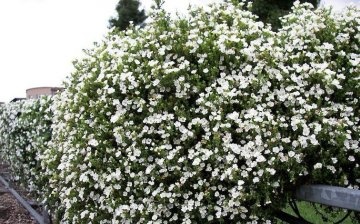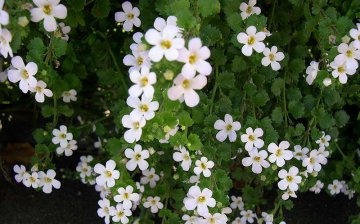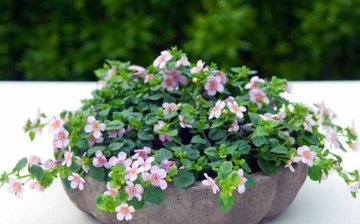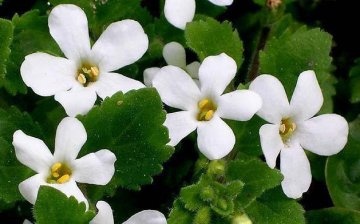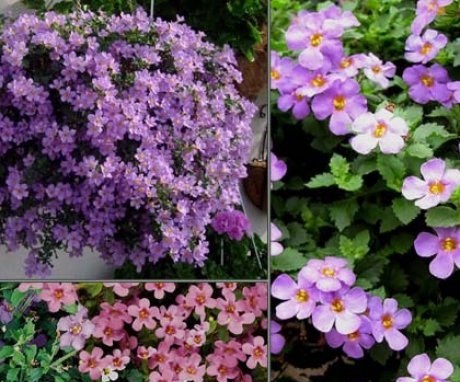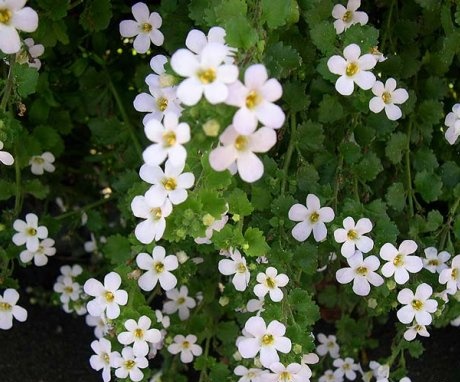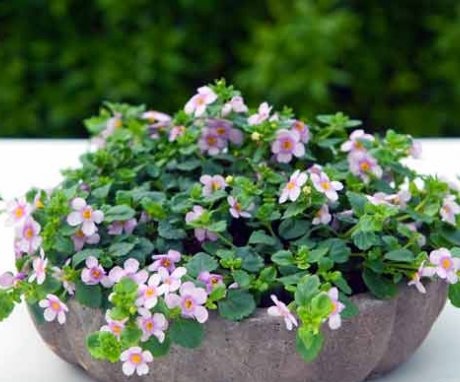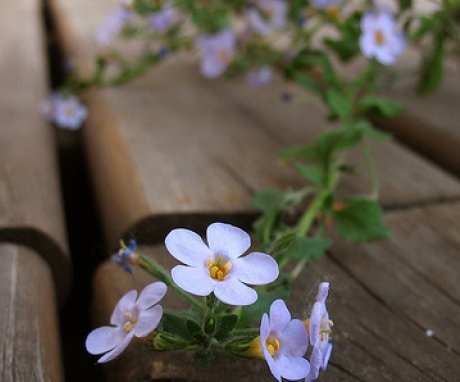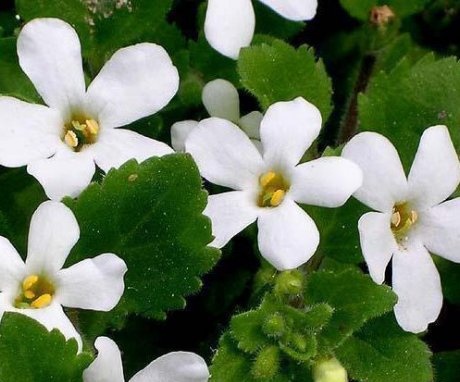Bacopa ampelous: description, varieties, reproduction and care
Bacopa ampelous is an ornamental, creeping plant of the norichnikov family. It refers to perennialsbut in cold regions with frosty winters it is grown as an annual plant. Bacopa is native to South Africa; in European countries, this plant is quite common among amateur flower growers and decorators. Bacopa ampelous came to the CIS countries about 20 years ago and every year its popularity is growing.
Content:
- General information about the plant
- Bacopa varieties
- Caring for ampelous bacopa
- Reproduction of ampelous bacopa
- Diseases and pests
- Plant application
General information about the plant
Bacopa is a herbaceous creeping and climbing plant whose branches can extend up to 70 cm in length. Small leaves are arranged in pairs on the branches. Painted in a greenish olive tone.
The flowers are densely located on the branches, the petals are painted in white, pink, purple and blue tones, depending on the variety.
Flowering lasts almost the entire season and takes place in waves. That is, the buds are tied and opened abundantly almost simultaneously, after flowering they fall off, and new ones grow in their place. Breeders annually develop new hybrid varieties of this plant.
When growing bacopa in pots or pots, for the winter it can be transferred for wintering in a room with a temperature of about 10 degrees. Overwintered plants are well suited for transplanting and cuttings.
Bacopa varieties
The most popular plant varieties
- Bluetopia. A perennial herb, the shoots of which stretch out to 30 cm. The leaves are small in size, painted in an olive-green tone, the flowers are densely located on the stems. The petals are painted in a beautiful bluish-lilac tone. The flowering is profuse and long lasting. The variety is resistant to diseases and easy to care for.
- Giant Snowflake. Belongs to large varieties. Perennial, the stems of which can be extended up to 90 cm in length. The leaves are small, green, on the branches are arranged in pairs. The flowers are white, large, densely located on the branches, when they bloom, they create a gorgeous cascading white waterfall, if grown in hanging pots. The care is not whimsical, the flowering period is several months.
- Olympic Gold. Perennial herb with branches reaching 60 cm in length. The variety is distinguished by the color of the leaves, they have a golden tint, which gives a special decorative effect to the bush. Their size is small, on the branches they are located in pairs. The flowers are medium-sized and white. Flowering is profuse and long lasting. The care is not whimsical and resistant to diseases.
- Snowstorm Blue. This variety can also be classified as large. Its branches can reach a meter in length. Leaves are medium in size, green. The flowers are large and densely arranged on the stems. The petals are painted in a bluish-lilac tone. Looks great with a combined planting with a large white-flowering variety. Resistant to disease.
- ScopiaDoubleBlue. Perennial herb. Small leaves are colored green. The flowers have a delicate pinkish-purple color. The stems extend up to 40 cm in length. Looks great when grown in hanging pots. The flowering is profuse and long lasting.
Caring for ampelous bacopa
Bacopa ampelous is very easy to care for. Timely watering and regularly pinching the shoots will make the bush a thick and blooming ball on the balcony or veranda.
Bacopa is demanding for watering. In nature, it grows in well-moisturized areas near water bodies, therefore watering should be regular and abundant.
In the open field, it is recommended to plant bushes in well-lit places where sunlight will illuminate the plant as much as possible.
The same recommendations apply to the placement of pots and pots on verandas and balconies. In shady places, the shoots of bacopa will greatly lengthen and thinner, stretching towards the sun, and flowering will be poor or almost nonexistent.
Bacopa ampelnaya prefers light fertile soil, consisting of peat, turf and sand. When growing in pots, a good drainage layer must be placed on the bottom. When planting a plant in open ground, it is necessary to wait for stable warm weather so that the soil is sufficiently warm. All care for soil bacopa consists in timely watering and removal weeds... When loosening the earth, it should be borne in mind that the root system is not deep. Therefore, the process is carried out with extreme caution.
For strong branching and an increase in the volume of the bush and the number of flowers, it is recommended to regularly pinch young shoots.
Before wintering in the autumn, the aerial part of the bush is cut off almost all of it. The pots are transferred to a room where the air temperature is within 10 degrees. In such an environment, the plant hibernates, the growth of branches stops. Bacopa is watered periodically. If the pot is placed in a warmer room, the branches will continue to develop at the same rate. But the plant can become weak and sick. Therefore, all gardeners recommend placing Bacopa in a dormant state for the winter.
Reproduction of ampelous bacopa
Bacopa reproduces with cuttings, layering and seeds... The processes are easy, since the plant has good seed germination and rooting of branches.
Propagation using cuttings:
- When grafting, the material is harvested in the winter months, if the plant is brought into a warm room during the cold season, or at the end of summer, from August to September. For this, young shoots are suitable, the length of which does not exceed 10 cm, and there are 2 pairs of leaves on the stem.
- For rooting, the bottom pair is removed, and the branches are placed in water with a stimulating solution for 2-3 hours. Thereafter cuttings can be planted in a substrate or transferred to regular water for further rooting.
- For rooting in the ground, you must first prepare the substrate. Light, loose, fertile soil is suitable for this. The cuttings are immersed in the soil in such a way that the place of growth of the lower leaves is covered with soil, and only the upper leaves remain above it.
- For seedlings it is necessary to maintain high humidity, therefore a greenhouse is installed above them with the help of a film. Periodically, it is removed for a short time in order to ventilate the plants and water.
- When young leaves appear, the film is removed. After the formation of 2 new pairs of leaves, it is recommended to pinch the top of the shoot. This stimulates the plant for additional branching, which later, when planted in a permanent place of growth, will give the bush additional volume.
Reproduction using layering:
- When propagating with the help of layering, after a short period of time, you can get a new well-flowering bush. To do this, a container with fertile soil is placed near the pot with the mother plant.
- Bacopa branches are laid out on the soil and well attached with an iron bracket. Due to the fact that the branches receive nutrition from the mother bush, their rooting takes place in a short time.
- After a while, the soil is carefully dug in and the degree of root development is checked.
- With a good result, the stems are separated from the mother bush, and the result is a new flowering bush.
Bacopa multiplies easily with seed:
- Experienced gardeners recommend mixing the seeds with river sand before sowing, since they are very light and you can get large losses during sowing.
- The soil must be prepared. It should be light, fertile, and good at retaining moisture.
- The seeds are laid out in moist soil and pressed down a little.
- The container is covered with a film to create increased humidity, and transferred to a warm, well-lit place.
- At an ambient temperature of 20 degrees, seedlings should appear in 13-15 days.
- After the first pair of leaves have appeared on the sprouts, they are dived into boxes at a distance of 2 cm from each other.
- Indoor temperature seedling, should be at least 23-25 degrees.
- Plant feed highly diluted fertilizers.
- When the young sprouts finally get stronger, they can dive in separate containers.
- Seedlings are planted in such a way that the lower node is underground.
- After that, young bacopa sprouts are hardened, lowering the temperature in the room, and after a certain time they can be planted on a balcony, veranda or in open ground.
Diseases and pests
Bacopa belongs to unpretentious plants with high resistance to diseases... In the spring-autumn period, she almost never gets sick. Sometimes branches can be infested with aphids.
If the insects were noticed quickly, the branches can be treated with soapy water 2-3 times at intervals of a week if necessary.
If this procedure does not help, then they resort to insecticides. Problems can begin in winter if the plant is not placed in a cold room. When growing bacopa in a room, there is always a threat to dry out the plant. During this period, it weakens and is attacked by the whitefly.
If this happens, the best option is to cut off the entire top and place the pot in a cooler room. Additional treatment with insecticides can greatly harm the plant.
Plant application
Bacopa is widely used as a potted hanging plant. Due to its dense appearance, long drooping branches, which are abundantly covered with flowers, it is used to decorate balconies, windows, verandas and gazebos.
Bacopa is often used by landscape designers as a groundcover.
It tolerates prolonged rainy weather well and continues to bloom without losing its decorative appearance. It can also be planted near a support, to which you can tie the stretching branches. In a short period, the plant will braid most of the wall, fence or gazebos... Large varieties are well suited for this, the branches of which can stretch up to 1 m in length.
More information can be found in the video.




